|
With the
hundreds, perhaps even thousands, of rifle scope choices available
to the average shooter, how does anyone reasonably select a scope to
purchase? Itís not easy. In many cases, weíll just look at something
a buddyís got on his gun, and if itís half way decent, weíll get one
too. Using such a method definitely has value. The scope in question
is a known quantity. Weíve probably looked through it, and so there
aren't going to be any surprises. On the other hand, that method of
selection can prevent us from trying something else that may be even
better suited to our needs, but because no one in our immediate
shooting circle has one to look at, thereís a fair chance weíll
never consider buying one. Another method would be to develop criteria by which to evaluate scope
features and characteristics to narrow down our choices and then make our
selection. This method is more flexible as the criteria can then be applied to
any number of scopes.
Letís get down to basics. What are criteria? Well, criteria are
standards, or measures that we use to judge something. So what standards should
be used to select a scope. Well, everyone has different needs, desires, and
pocketbooks, so to say that one set of criteria will satisfy everyone would be
kind of silly. Never the less, the personal criteria which Iíll discuss here can
get the wheels turning in your own mind about what is, and is not important to
you, so when the time comes, youíll be able to clearly formulate your own
criteria. To illustrate, Iíll use my recent evaluation and selection of a
Nikon
6.5 X 20 Monarch
scope with their Ultra Clear Coatings as a basis of discussion.
|
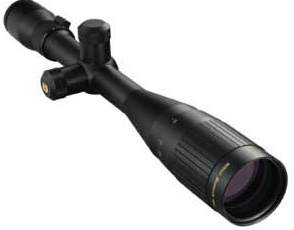 |
|
The Nikon Monarch 6.5 X 20
with Nikonís legendary optical
glass, innovative design and their new Ultra Clear Coatings.
|
|
Versatility Personally, I value versatility the most
over all other characteristics. In other words, I like scopes that can be used
for more than one application. On the other hand, some folks like very
specialized kinds of scopes instead i.e. those that may have been custom
modified by bumping up the power, or have specialized reticules, or because of
some characteristic, are really geared for only one type of application. Thereís
certainly nothing wrong with that if thatís whatís good for you. In fact, I own
such a scope myself. Itís an outstanding airgun scope with a huge amount of very
bright magnification power that will focus down to a mere 8 meters. On the other
hand, it canít focus beyond 100 yards. Consequently, itís versatility is pretty
limited.
Generally speaking, I
like a scope that I can mount on my Field Pistol Thompson Contender 22 Hornet,
and then if I tire of that category, I can then mount it on my standing
unlimited XP-100 the following year. Perhaps, I might even put it on my
Remington 40X to do some rimfire benchrest shooting or on my 222 Kimber to pop
some coyotes or jacks. The way I look at it, if Iím going to put out my hard
earned cash, I want a scope that can do double, and triple, and even quadruple
duty.
Power Obviously, single power scopes aren't very
versatile. This is where the variables really shine. However, these days,
thereís a ton of variable ranges available. Generally speaking, the higher or
lower the variable range, the more specialized the scope becomes. For maximum
versatility, a middle range of powers is best. I guess thatís what attracted me
to the Nikon Monarch 6.5 X 20. If I want a relatively high power for Field
Pistol or long range varmint shooting, itís there. If I want around 12X for my
Unlimited Standing gun, it can be easily accommodated. If I want to focus close
in at 50 yards to test some rimfire ammo or go way out to hit a ground squirrel
at 250 yards thereís no problem. This Nikon with its middle variable
magnification range can do it all.
Brightness Power and brightness are mutual enemies.
Higher magnification powers work to reduce resolution, color fidelity, and image
brightness. This is another argument against variable scopes with really high
magnification ranges. In order to compensate for the image degrading effects of
those higher powers, the manufacturers of high quality scopes have to use very
expensive components and huge objective lenses which, of course, drives the cost
way up. What you get then is a compromise where you have high magnification
taking priority at the expense of brightness. Brightness will still be ok, but
sometimes, not great. For inexpensive, lesser quality scopes with very high
magnification powers, brightness and resolution at the top end can be pretty
disappointing.
With the Monarch 6.5 X 20, theyíve taken a different tack. They use
Nikonís legendary optical glass, innovative design, their new Ultra Clear
Coatings, and coupled them to a some what lower variable power range. Here, the
compromise has been tilted towards brightness and away from power. The result is
a very clear, bright image with lots of fidelity where colors aren't washed out
or muddy. To be honest, Iíd rather sacrifice some power for a first class image
any time.
I should also explain that one of the features that significantly
contribute to the Nikonís bright image is the Ultra Clear Coatings (UCC)
introduced just recently. These new lens coatings will in fact, bring the light
transmission rate up to a very impressive 95%. Considering that all the optical
surfaces of all the lenses in a scope are scattering light some where else away
from your eye, a 95% rate is a technical accomplishment of the first order.
Fast Focus Eyepiece Unless your eyes are absolutely
perfect, the eye piece on any new scope must be adjusted to insure that the
reticule is in perfect, super crisp focus. If your view of the crosshairs is the
least bit fuzzy, your ability to produce consistent results will suffer.
|
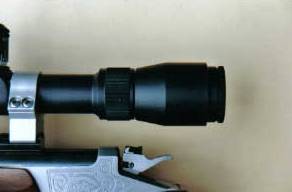 |
|
"The fast focus eyepiece is much easier to use." |
With most scopes, in order
to adjust adjust this focus, you screw out the eye piece lens assembly
which is mounted on very fine threads. This usually involves a lot of
turning and turning of that lens assembly. On the other hand, the Nikon
uses the new fast focus method of making this adjustment. This is more of
a twist and pull or a twist and push method of moving the assembly in and
out to reach the proper position. It is infinitely faster and just as
precise as the old way. I wonít go back to scopes that donít have this
feature unless there is no other choice.
By the way, when adjusting this focus, make sure the scope is pointed at a blank
background to insure you can see the reticule with perfect clarity and without
any interference. I usually will just staple a blank sheet of printer paper on a
target board at 50 yards when making this adjustment.
Zero Set Target Knobs The Nikon is equipped
with some very nice high target knobs and I really wish that all scopes were
equipped this way. Unless you intend to use your scope in a dense, tropical
jungle where the knobs might get snagged on a hanging vine or something like
that, I really donít see why this convenient means of rapidly and easily making
scope adjustments canít be a standard feature. These knobs with the protective
caps on are 1.25" tall, and 1 and 1/8 inches without the caps. Thereís also a
rubber gasket at the base of the knobs so when you screw down the cap, thereís a
good moisture proof seal. The knobs have also got a nice double line of deep
knurling at the top for good finger grip. Whatís really impressive is the fact
that the index markings and numbers on the side of the knobs are super clear and
distinct, making them very easy to see even in less than perfect lighting.
For target shooters, having turrets that can be set to zero is
important to accurately keep track of where youíre at in elevation or windage.
Once you have determined your basic elevation setting for a given distance,
whether itís 50 meters for a pistol silhouette chicken or perhaps a 100 yard
setting for a rifle, just remove the screw on top of the turret with an Allan
wrench. Now take off the barrel of the turret and replace it so that numeral
"zero" is aligned with the index mark, tighten up again and youíre set. If you
need to click up or down, youíll know that when you return the knob back to
"zero" it will always be set back to the original point of impact.
|
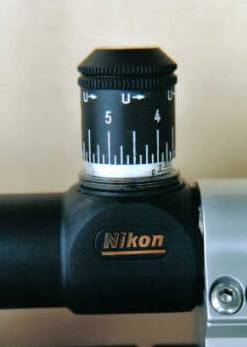 |
|
"The
markings on the adjustment knobs are very distinct and double
knurling prevents any slippage." |
|
Lastly and perhaps, most important of all is the fact that the Nikon
Monarchís clicks fall into place with a very positive and distinct "thunk". No
slop. No wiggle. Just thunk, thunk, thunk. Consequently, youíll never need to worry
about sliding over or under a sight setting because of weak and indistinct
clicks on this scope.
Positive Grip On Adjusting
Surfaces There are basically
four adjusting surfaces on most scopes. The eyepiece focus, the power ring, the
windage and elevation knobs, and the objective lens ring. All of these adjusting
surfaces on the Nikon were nicely knurled for a good grip except the objective
lens ring. That surface is nice and wide and has a series of 1 3/4" grooves cut
into the surface to assist gripping. However, the surface and finish on the
scope is very smooth and fine, depicting itís obvious high quality. Coupled with
that is the fact that the ring, by design, is fairly stiff to turn in order
prevent it from moving during heavy recoil. When adjusting parallax a shooter
will be holding the gun with one hand, looking through the eyepiece, and turning
the AO ring with the other hand.
The very smooth, slick surface combined with the stiffness of the
adjustment ring makes this difficult to accomplish while looking through the
eyepiece.
|
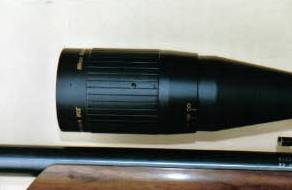 |
|
"The finish on the
parallax adjustment ring is very smooth" |
|
Well Fitting Lens Caps This is strictly a nice to have
but itís something Iíve got this thing about. Iíve written about good,
functional lens caps and how they are important to insure that the lenses of our
often expensive scopes stay free from dirt, film, grit, etc. Dirty lenses can
degrade any top quality scopeís performance to be similar to that of a $79.95
catalog special. Screw on caps (metal or plastic) are usually best as they fit
tight. They therefore give very good protection. To go a step farther, however,
I wish someone would put a rubber ring on the inside of the screw on lens caps
so they could provide a even better seal against dirt and moisture. Another
advantage is that the screw ons wonít fall off either. The Nikon was equipped
with two slip over plastic lens caps linked with an single elastic cord. The
caps, because they were being pulled toward each other on only one side by the
elastic cord were an uneven and so-so fit.
|
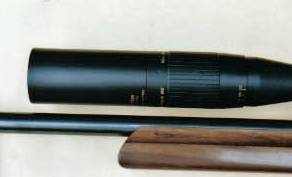 |
|
"The
4" metal sunshade helped increase contrast when pointing into the
sun." |
|
Sunshades My range faces East and so for a substantial
portion of the morning, youíre looking into the sun in spite of the covered
firing lineís roof. The Nikon came equipped with a very substantial metal
sunshade that was just a little over four inches in length. It worked great. I
wish all scopes came equipped with sunshades like this one.
Despite a couple of nits, I found the Nikon Monarch with the Ultra
Clear Coating to be a first class scope with one of the nicest, brightest images
Iíve seen, and thatís whatís itís all about. With its rich, deep black matte
finish, gold lettering, and the gold Nikon crest on top of the vertical
adjustment turret cap, itís a very visually attractive scope as well. This is
one scope that can do many jobs and do them very, very well indeed. If youíre
shopping for a high quality, versatile scope, give it a look. It also carries a
no hassle life time warrantee.
|
![]()